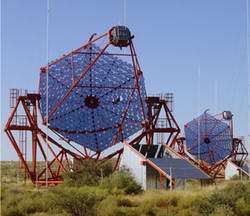Searching the Sources of Mysterious Particles from the Universe

The H.E.S.S. Telescope system, a new scout to the high-energy universe, will be opened on September 28, 2004 in the vicinity of the Gamsberg/Namibia
A new system of large telescopes, dedicated to the search of the sources of high energetic particles with energies of more than 100 GeV, like supernova remnants and other exotic objects, will be opened on September 28, 2004 by the prime minister of the Republic of Namibia, Dr. Theo-Ben Gurirab. Numerous high-ranking guests from Namibia, South Africa, France and Germany will attend the ceremony on the Farm Goellschau in Namibia. The international project, which is coordinated by the Max Planck Institute for Nuclear Physics, is based on technologies from particle physics. It provides a powerful instrument for the young research field of TeV-astronomy, and may for the first time allow the detection of "dark matter" in the universe. The inauguration of the four telescopes marks the completion of the installation of the first phase of H.E.S.S. The telescope system can start its work for the benefit of the worldwide astronomical community.
H.E.S.S., the "High Energy Stereoscopic System", is designed to search the electromagnetic spectrum of the sky in the Southern Hemisphere for the sources of extremely high energy particles and enables fundamental research in the fields of astronomy and astrophysics. H.E.S.S. is a collaboration between many European and African institutions.
The H.E.S.S. telescope system was realized in close cooperation with the University of Namibia. It supports the international cooperation in fundamental research as well as the education of young scientists and technicians in southern Africa. The project was initiated by the Max Planck Institute for Nuclear Physics in Heidelberg. Major components of the telescopes and the infrastructure were provided by the Max-Planck-Gesellschaft and the Max Planck Institute for Nuclear Physics in close collaboration with research groups from the universities of Hamburg and Bochum, the Humboldt-University of Berlin and from the Landessternwarte Heidelberg, with support from the Federal German Ministry für Education and Research (Bundesministerium für Bildung und Forschung (BMBF)) within the funding framework "Astroteilchenphysik". Important technical contributions came from the French collaboration partners. The other international partners from Europe and southern Africa provided valuable additional contributions to the project.
The new research instrument consists in its first phase of a cluster of 4 optical telescopes, which are coupled to a system and which can be extended in a later stage. The experiment is designed to operate initially for about 10 to 15 years. Namibian companies, like NEC and Seelenbinder Consulting Engineers, have realized the technical infrastructure in close cooperation to the highest technical level.
First observations with H.E.S.S. have been performed during the stepwise commissioning of the individual telescopes in 2002 and 2003. From these measurements important results have already been obtained and which marked scientific highlights at conferences on astroparticle physics in 2004. Among these results is the discovery of a source of high-energy gamma rays at the center of our Galaxy, which is probably a remnant of a supernova that exploded about 10,000 years ago.
The inauguration of H.E.S.S. takes place on Tuesday, September 28, 2004 at 10.30 am local time at the location of H.E.S.S. on the Farm Goellschau in Namibia.
Source: Max Planck Society


















